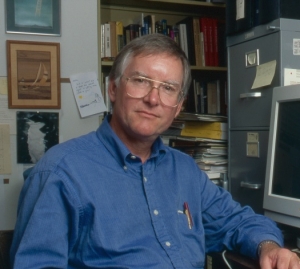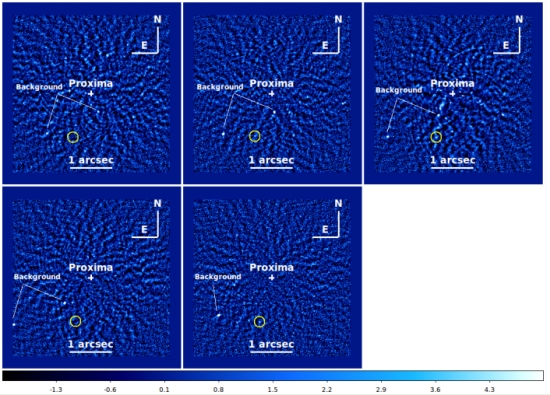Hard on the heels of the confirmation of Proxima Centauri b, we get news of Proxima c, which has now been analyzed in new work by Fritz Benedict (McDonald Observatory, University of Texas at Austin). Benedict has presented his findings at the ongoing virtual meeting of the American Astronomical Society, which ends today. The work follows up and lends weight to the discovery of Proxima c announced earlier this year by a team led by Mario Damasso of Italy’s National Institute for Astrophysics (INAF), which had used radial velocity methods to observe the star. We need further work, however, to say that Proxima c has been confirmed, as Dr. Benedict explained in an email this morning.
But first, let’s straighten out a question of identity. Yesterday, when discussing the confirmation of habitable zone world Proxima b, we talked about a second signal in data culled by the ESPRESSO spectrograph. If the second ESPRESSO signal does turn out to be a planet, it will be a third Proxima Centauri planet, not Proxima c. That signal does not rise to candidate planet status, nor does the ESPRESSO team claim it as such, but it suggests a minimum mass about a third of Earth’s at an orbital distance inside Proxima b in a five-day orbit.

Proxima c as studied by Benedict is a different world entirely. What the new work addresses is the Damasso finding of a planet in a 1,907-day orbit at a distance of 1.5 AU, well outside the star’s habitable zone. Seeing Damasso’s work, Benedict made the decision to re-examine data he had collected on Proxima Centauri using the Fine Guidance Sensors (FGS) on the Hubble Space Telescope. This is a classic case of tapping old data, as the Hubble work was done in the 1990s.
Image: Fritz Benedict, emeritus senior research scientist with the University of Texas at Austin’s McDonald Observatory. Credit: McDonald Observatory
And while Damasso used radial velocity methods (examining the star’s movements toward and away from Earth as influenced by planetary companions), the Hubble FGS, which were designed for pointing accuracy, allowed Benedict to use astrometry, the measurement of the positions and motions of stars. In the earlier study, Benedict worked with Barbara MacArthur, also at McDonald Observatory, to look for planets with orbital periods of 1,000 days or fewer, and found none. A re-investigation of the dataset looking for planets in longer orbital periods turned up the signal at 1,907 days.
Benedict then turned to images collected by INAF’s Raffaele Gratton using the SPHERE instrument on the Very Large Telescope in Chile, which showed what could be Proxima c at several points in its orbit. In An Image of Proxima c?, I ran a figure from the Gratton paper reproduced below, along with the paper’s caption.

Image: This is Figure 2 from the paper. The SPHERE images were acquired during four years through a survey called SHINE, and as the authors note, “We did not obtain a clear detection.” The figure caption in the paper reads like this: Fig. 2. Individual S/N maps for the five 2018 epochs. From left to right: Top row: MJD 58222, 58227, 58244; bottom row: 58257, 58288. The candidate counterpart of Proxima c is circled. Note the presence of some bright background sources not subtracted from the individual images. However, they move rapidly due to the large proper motion of Proxima, so that they are not as clear in the median image of Figure 1. The colour bar is the S/N. S/N detection is at S/N=2.2 (MJD 58222), 3.4 (MJD 58227), 5.9 (MJD 58244), 1.2 (MJD=58257), and 4.1 (MJD58288). Credit: Gratton et al.
What we now have on Proxima c, then, is the result of Hubble astrometry, radial velocity studies (Damasso et al.) and direct imaging (Gratton et al.), all of which allowed Benedict to refine the mass of the planet to about 7 times that of Earth. Older data serve us well.
“Basically, this is a story of how old data can be very useful when you get new information,” Benedict said. “It’s also a story of how hard it is to retire if you’re an astronomer, because this is fun stuff to do!”
Amen to that. Indeed, it’s hard to see how any astronomers specializing in planets around other stars could bring themselves to retire as we go ever deeper into what will surely be described as the ‘golden age’ of exoplanet studies.
When I contacted Dr. Benedict this morning, he told me that for now, his official statement on Proxima Centauri c is “A Preliminary Mass for Proxima Centauri C,” in Research Notes of the AAS Volume 4, Issue 4, id.46 (full text).
Because the individual detections from FGS, radial velocity and imaging, are all at the limit of detection, we should look toward more observations from SPHERE and future Gaia data on orbital perturbation at Proxima Centauri to serve as a further check for confirmation.



If one could get the angle of the plane of the orbit of Proxima c from those images and we could assume that Proxima b has the same angle we can then get the proper mass of Proxima b.
Am I understanding it correctly?
We can only derive a minimum mass from radial velocity in the absence of any information about the planet’s orbital inclination. But yes, if we could figure out the plane of Proxima c’s orbit — again, assuming this planet exists — then we could get a pretty tight estimate of Proxima b’s mass. This would assume, as you say, that the two planets were co-planar.
Why don’t you calculate the distance between the 2 planets first ,then the distance between the red sun and the time it takes to orbit that should give you the size of planet if I am correct, just a thought I Love the science of planets and Solar systems and believe I understand alot about space and time just don’t know how I understand the things I think about but I can come up with crazy theories in my head. God bless have a great day and remember religion and science are one, trust me!
Interesting, the “A Preliminary Mass for Proxima Centauri C,” in Research Notes of the AAS states at the end of the statement that Proxima b has a mass 3 times of earth.
“Assuming a coplanar system, Proxima?b would have M b = 3 +/-
0.3 M of Earth. Gaia will eventually provide better companion masses.”
Judging by our meager (it’s not meager at all really, it’s truly amazing) ability to ferret out this kind of data, then if we are to persist into the distant future in one form or another, we will be able to image nearly every star system with the galaxy. If they exist at all, then at least a few are very ancient and they know something is special about our planet.
If the 3 earth mass is correct and the latest report says Proxima b is 1.17 and Proxima d is .29 earth mass then could it be that there are more planets amounting to 1.5 earth mass in the inner system around Proxima.
The other group said that they did not see any smaller then .4 earth mass near the habitable zone but 4 planets of .4 mass could be there and and 5 planets if they have a similar mass to Proxima d for a total of up to eight planets in the whole system! Is this a possibility? Hopefully the 10 cm/s will clear this up along with Gaia’s data.
When we talk about looking for planets around our closest neighbors, I think back to this article here on Centauri Dreams discussing a “Stare” mission focusing on one star:
https://centauri-dreams.org/2015/03/30/an-alpha-centauri-bb-transit-search/
Seems there’s been some recent work done toward that general end, involving the “usual suspects” of Sara Seager and also Brice-Oliver Demory from the prior article and its comments.
http://www.parabolicarc.com/2020/06/02/jpl-mission-breaks-record-for-smallest-satellite-to-detect-an-exoplanet/
Actually, Kervela et al.have infered the inclination of
the Proxima c orbit from Gaia data:
Orbital inclination and mass of the exoplanet candidate Proxima c
Astron. & Astrophys., 635, L14
https://doi.org/10.1051/0004-6361/202037551
It’s worth noting that the FGS orbit in Benedict & McArthur (2020) is consistent with the preliminary astrometric orbit derived using Gaia DR2 data (Kervella, Arenou & Schneider, 2020), which presumably strengthens the case for this orbit being correct.
The imaged candidate shows a ~3? discrepancy from the position predicted by the astrometric orbits (see §4.2 in the Gratton et al. paper), which suggests that either something else is going on in the system (e.g. an additional massive outer planet causing deviations in the astrometry), or that one or more of the detections is in error.
Used in this article images allow to biased human (astronomer’s) imagination to “see” the planet in every point (pixel) on this noisy image, I do not think it is good idea to use those pictures as proof of planet c existence or absence.